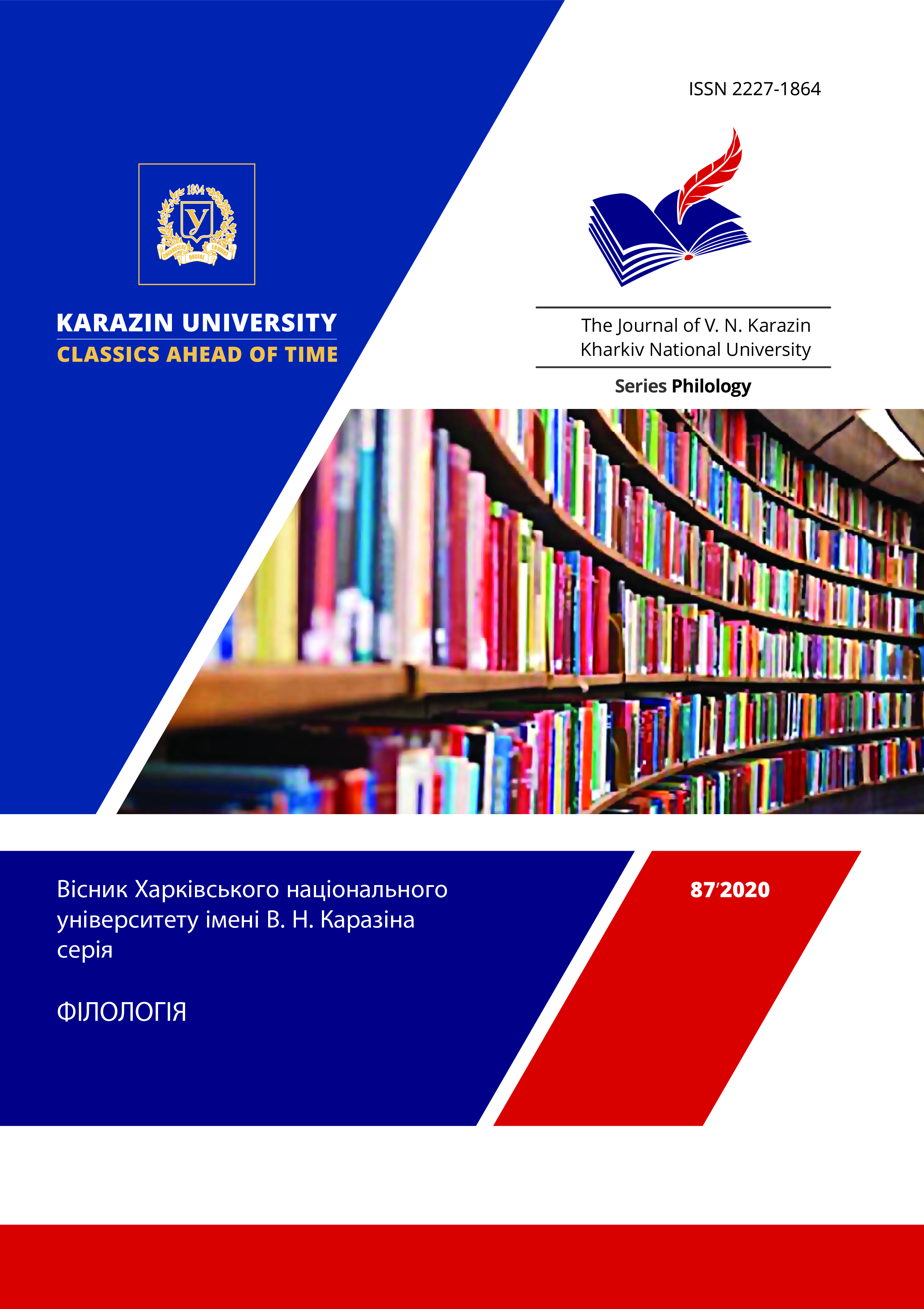The functions of coloratives in the Veronica Dolina’s poetic world view
Abstract
The article deals with the results of analysis of coloratives in the Veronica Dolina’s poetic world view. Veronica Dolina is one of the most famous contemporary Russian poetess-bards. Her creation inherits the traditions of Russian women lyrics of XX century, the poetry by A. Akhmatova and M. Czvetayeva in particular. The collection of the coloratives is identified. The сollection of coloratives is diverse and coincides with the common Russian language set. The color dualism of V. Dolina’s world view, fight between light and dark, white and black in particular is marked. The main functions of coloratives in lyric texts by V. Dolina are defined, such as: artistic and expressive that means to describe interior things, natural phenomena, appearance of characters and lyrical heroine; characterizing function that means to characterize lyric heroines’ feelings, emotions; evaluation function than means to evaluate interior objects and lyric heroines’ internal experience; esthetic function than means the authors’ original transformation of coloratives; meaning-making and text-making functions that mean to transformed things and abstract concepts with color epithets into separate poetic characters, to feel them with special original life meaning. It is emphasized that color lexemes represent the V. Dolina’s specific poetic world view characteristics such as integrity of perception, an inseparable connection of the perceived visually objective world with the world of woman’s soul emotions. All these facts allow to V. Dolina maximally individualize her own poetic world view. The color spectrum surrounding the lyric heroine, the circumstances she perceives when thinking about the future and the present correlates with the lyric heroine’s feelings and emotions. The research perspective is conceptual analysis of the V. Dolina’s poetic world view.
Downloads
References
Baxy`ly`na N. B. (1975). Y`story`ya czvetooboznacheny`j v russkom yazыke. Moskva: Nauka. 288 s.
Belen'kyy L. P. (2017).Sekret uspekha: o pryrode khudozhestvennoho tvorchestva v avtorskoy pesne // Zhurnal «Pro DOD». URL: https://prodod.moscow/archives/1924 (data zvernennia: 15.10.2020).
Vy`nogradov V. V. (1959). O yazыke xudozhestvennoj ly`teraturы. Moskva: Y`zd-vo AN SSSR. 654 s.
Voynalovych E. V. (2015). Leksyko-semantycheskoe pole koloratyvov v romane Y. S. Shmeleva «Nyanya yz Moskvы» // Humanytarnыe yssledovanyya v Vostochnoy Sybyry y na Dal'nem Vostoke. # 1. S. 97-103. URL: https://www.elibrary.ru/contents.asp?issueid=1406880 (data zvernennia: 15.10.2020).
Glejzer Y`. (1998). Verony`ka Doly`na: Ot pervogo rozhden`ya do vtorogo // «Russky`j Y`zray`l`tyany`n». URL: http://www.bard.ru/article/8/17.htm (data zvernennia: 15.10.2020).
Doly`na V. A. (2006). Pesny`. Moskva: «Vremya». 448 s.
Doly`na V. A. (2008). Sty`xy` o lyubvy`. Moskva: «Эksmo». 256 s.
Doly`na V. A. (2001). Sэlyavy`: Sborny`k sty`xotvoreny`j y` prozы. Moskva: «Эksmo-press». 416 s.
Doly`na V. A. (2015). Czvetnoj bul`var. Moskva: «Эksmo». 320 s.
Kadochnykova S. A. (2018). Zhurnalyst•skyy dyskurs v khudozhestvennoy systeme avtorskoy pesny. Pesnya-reportazh kak ynformatsyonno-lyrycheskyy zhanr // Voprosы lyteraturы. # 4. S. 173-190. URL: https://volpit.ru/article/zhurnalistskij-diskurs-v-sisteme-avtorskoj-pesni-pesnya-reportazh-kak-informatsionno-liricheskij-zhanr/ (data zvernennia: 15.10.2020).
Kapnyna H. Y., Korotyaeva Y. B. (2016). Kontsept «tsvet» v yazыkovoy kartyne myra // Fylolohyya y lynhvystyka. # 1(3). S. 20-23. URL: https://moluch.ru/th/6/archive/23/205/ (data zvernennia: 15.10.2020).
Кramkova O. V. (2019). Opыt leksykohrafycheskoho opysanyya tsvetooboznachenyy v russkom yazыke («Slovar' tsveta y tsvetovыkh ottenkov», N. Novhorod, 2014) // Sotsyal'nыe transformatsyy. Smolensk: Smolenskyy hosudarstvennыy unyversytet. S. 98-103. URL: https://www.elibrary.ru/item.asp?id=41391848 (data zvernennia: 15.10.2020).
Lopteva T. S. (2017). Yndyvydual'no-avtorskye koloratyvы v stykhotvorenyyakh M. Y. Tsvetaevoy (na osnove sbornykov 1913-1925 hh.) // Molodoy uchenыy. # 3 (137). S. 653-656. URL: https://moluch.ru/archive/137/38398 (data zvernennia: 15.10.2020).
Morshchynskyy V. S. (2017).Эmotyvnaya semantyka koloratyvov v proze L. N. Andreeva // Fylolohycheskye nauky. Voprosы teoryy y praktyky. Tambov: Hramota. # 5 (71). S. 118-122. URL: https://cyberleninka.ru/article/n/emotivnaya-semantica-kolorativov-v-proze-l-n-andreeva (data zvernennia: 15.10.2020).
Norman B. Yu. (2019). Otdalennoe znakomstvo slov // Psykholynhvystycheskye aspektы yzuchenyya rechevoy deyatel'nosty. Ekaterynburh: Ural'skyy hosudarstvennыy pedahohycheskyy unyversytet. # 17. S. 155-178. URL: https://www.elibrery.ru/item.asp?id=38228067 (data zvernennia: 15.10.2020).
Potebnya A. A. (1990). Teorety`cheskaya poэty`ka / Sost., vstup. st., komment. A. B. Muratova. Moskva: Vыsshaya shkola. 344 s.
Mnich L. (2016). «Poэt – u dreva vremeny` otrostok...»: Poэty`ka y` sy`mvoly`ka tekstov Verony`ky` Doly`noj. Siedlce: Instytut Kultury Regionalnej i Badań Literackich im. Franciszka Karpińskiego. Stowarzyszenie. 178 с. URL: https://repozytorium.uph.edu.pl/bitstream/handle/11331/1221/Mnich%20Ludmila.Dolina.pdf?sequence=1 (data zvernennia: 15.10.2020).




